WordPress is the most popular content management system. Period. If you have a WordPress site — which you should if your site is a content site — you know how many plugins are available on this platform. There are thousands, literally thousands. I did a search today to see how many WordPress plugins there are. The number? 54,681. It can be a bit overwhelming. With so many plugins to choose from, how can you know which ones are the best?
What you do know is that you want to add a calendar feature to your website. Being able to simply add dates and times is crucial for some businesses. Not every calendar plugin is the same. Some of you will need more advanced calendar features than others. You may need a calendar to keep track of tasks — pretty basic. Or, you may need a more advanced calendar for managing events, bookings, and integrating with ecommerce platforms.
I took the time to find the best WordPress calendar plugins available. So regardless of your situation, you can use this guide to find the one that best suits your needs.
1. The Events Calendar
As the name implies, The Events Calendar WordPress plugin is ideal for any site that’s managing events. There are so many different uses for this feature.
It’s great for musicians who want to showcase their upcoming performances, as well as venue owners who need to display shows coming to their location. If you have a restaurant, church, or nonprofit organization, this plugin is perfect for you. If you’re an author and traveling to promote your book, or speaking at any seminars and conferences, you can benefit from the events calendar. As you can see from these examples, the possibilities are nearly limitless.
Here’s how the plugin looks once you implement it:

In addition to this month view option, you can also organize the calendar by day or list of events.
The microformats will help boost your SEO, and the plugin offers caching support as well as debug mode. It’s compatible with Google Maps, Google Calendar, and iCal as well. So events can be exported and added to other platforms.
Users who are looking at the calendar even have the option to browse for certain events. They won’t have to scroll to find something specific.
The design is fully responsive no matter what device the calendar is being used on. So you won’t have to worry if visitors are browsing from desktops, smartphones, or tablets. This is extremely important since accommodating the needs of mobile users can boost sales.
One of the reasons why The Events Calendar is so popular is because it’s easy to use right out of the box. You’ll be able to figure out how to navigate and use everything in minutes.
You can install this plugin for free, but it does have a few paid options as well. The premium upgrades are very affordable — they cost $89, $149, and $299 per year for personal, business, and agency use, respectively.
2. Booking Calendar
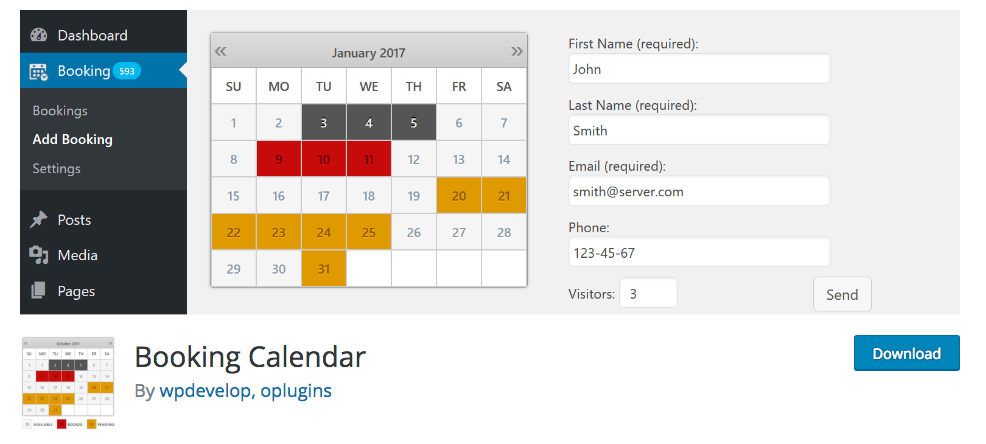
The Booking Calendar is one of the first booking systems ever developed for WordPress. It was originally released back in 2009. Over the last decade, it’s been installed on WordPress sites more than one million times.
It’s safe to say that this plugin has gone through its fair share of updates and changes over the past ten years, which has helped it keep its spot as one of the best WordPress calendar plugins in 2019.
This plugin makes it easy for website visitors to view the availability of something, such as an apartment, hotel, or service, and book directly from the calendar.
Here’s how it works: Let’s say you own a carpet cleaning business. Rather than taking appointments over the phone, which can be inefficient, it’s easy for you to add a user-friendly calendar to your WordPress site. Website visitors can select the day and time for an appointment and fill out form fields to book the cleaning. This is much more user-friendly than requiring them to pick up the phone and going back and forth about possible dates. I know I’d much rather book online. If you make me pick up a phone, I’m a lot less likely to follow through with the booking.
As you can see, the functionality of this plugin can be applied to so many different websites and businesses. From the backend, it’s easy for the admin to view, manage, and customize all of the bookings. Booking Calendar lets you set limits to avoid double bookings. Dates and times will automatically become unavailable once your limits have been reached. This calendar plugin can manage an entire year in advance.
The administrative features give you the option to approve or deny bookings as well. You can set it up so you receive email notifications when something gets added to your calendar. That way you can plan your schedule accordingly, and won’t have to keep manually checking WordPress to see if anything has been changed.
3. Simple Calendar – Google Calendar Plugin
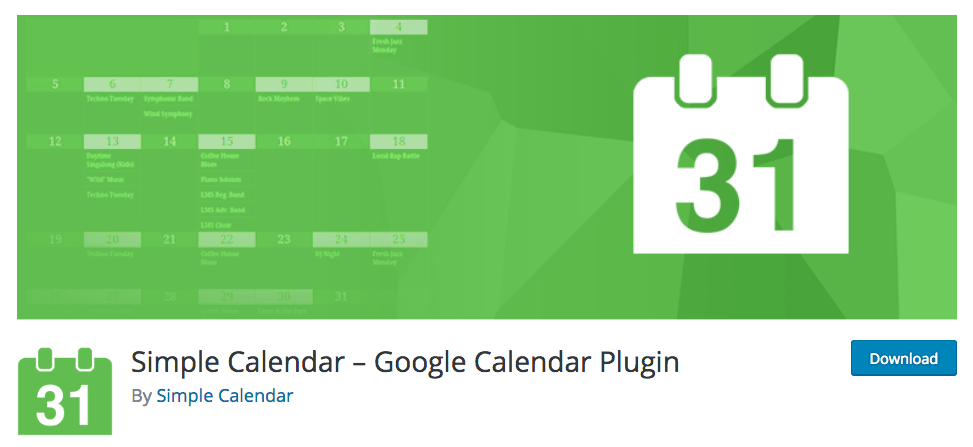
I don’t mean to be redundant, but the Simple Calendar – Google Calendar Plugin is as simple as it gets. The reason why it made my list is because it’s so easy for anyone to use, even if you don’t have any technical experience.
This plugin has more limited features compared to other calendars, but sometimes too many elements add unnecessary complexity. For those of you who don’t need all of the extras and frills, the Simple Calendar – Google Calendar Plugin is perfect.
Once you install the plugin, you’ll be able to display any event from a Google Calendar, which means you won’t need to re-create any events manually in WordPress.
You can use tags to customize your events without having to do any coding.
It’s easy to integrate this plugin with other tools to turn your calendar into a format that’s easy to distribute as a newsletter. This feature allows you to share the calendar with your email subscribers without requiring them to to visit your website.
Like most options, this plugin lets you view calendars in a monthly grid or a list view. The advanced settings will automatically adjust for time zones, as well as the date and time formats, depending on where your site visitors are located.
I’d recommend this plugin to anyone who doesn’t needed too many advanced features in a WordPress calendar. For lack of a better word, I’d describe this plugin the same way it does — simple.
4. EventON
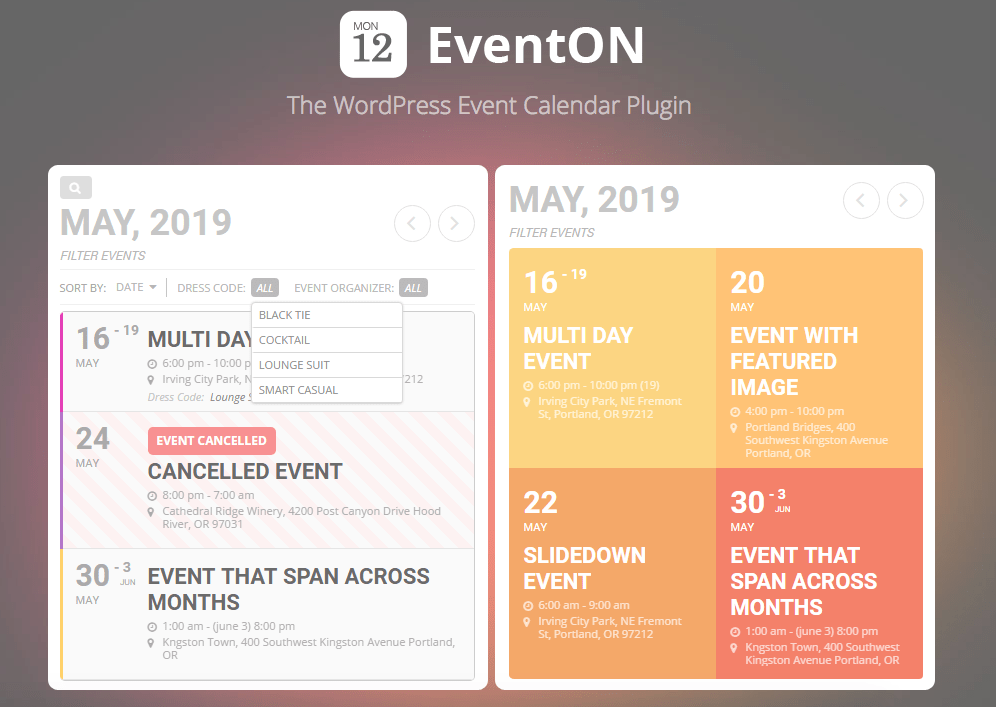
As you probably guessed, the EventON WordPress plugin is made for managing events.
The design of this calendar is what makes this plugin stand apart from other options. If you want a sleek and beautifully designed calendar that fits with your pages and themes, this will be a top choice for you to consider. With this plugin you can customize the look to match with the trending color schemes on your website.
There’s a lot to like about it as well. It’s easy for users to search for events or navigate from month to month. It readily handles events lasting for multiple days, months at a time, or even all year. And, you can highlight featured events that you want to promote more and jump off of the page. Each event has a title, date, time, address, and photo. You can also add a description of the event, as well as an additional image showing the location.

People can even get directions to the location directly from the event listing on your website. All they need to do is type their address into Google Maps, which is integrated on the screen.
EventON lets users buy tickets to events with Woocommerce support. But you’ll need to pay extra for that add on.
EventON is arguably the best WordPress calendar plugin for managing and promoting events on your website. It’s not free, but there is a demo for you to try if you’re interested. All of the premium features are purchased separately, so you can customize the plugin to meet your needs.
5. All-in-One Event Calendar
All-in-One Event Calendar is another one of my favorite WordPress plugins. I like it because it’s so easy to use within WordPress. Just look at how simple this new event page is to configure.
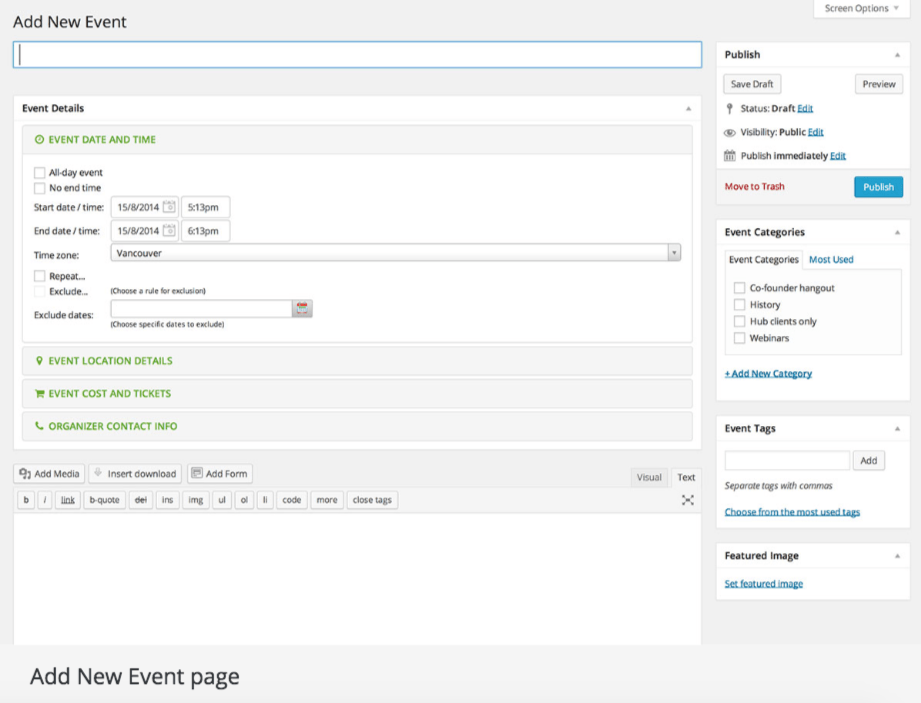
Everything is so straightforward. All you need to do is fill out the form fields, add the dates and times, and you’re good to go. There are settings for the location details, contact information, as well as a section for purchasing tickets. The plugin automatically helps optimize your events for SEO purposes. You can embed Google Maps into each event as well, so it’s one less step for people who need directions. They can do this directly from your website.
You can sync All-in-One Event Calendar with other platforms, including:
- Google Calendar
- iCalendar
- MS Outlook
Site visitors can view the calendar by month, week, day, or poster board and it’s easy to filter events. I especially like the color coding feature for grouping events in certain categories. For example, let’s say you own a restaurant. You can add different colors for things like karaoke, trivia, or happy hour, so it’s easy for people to find what they’re looking for. (For me, that’d be a hard no on karaoke, and a hearty yes on trivia and happy hour.)
The basic version of All-in-One Event Calendar is free. The pro version starts at $9 per month, but there are more advanced options for $29 and $99. But I think the majority of sites will have their needs met with the free version or the $9 pro version at most.
6. My Calendar
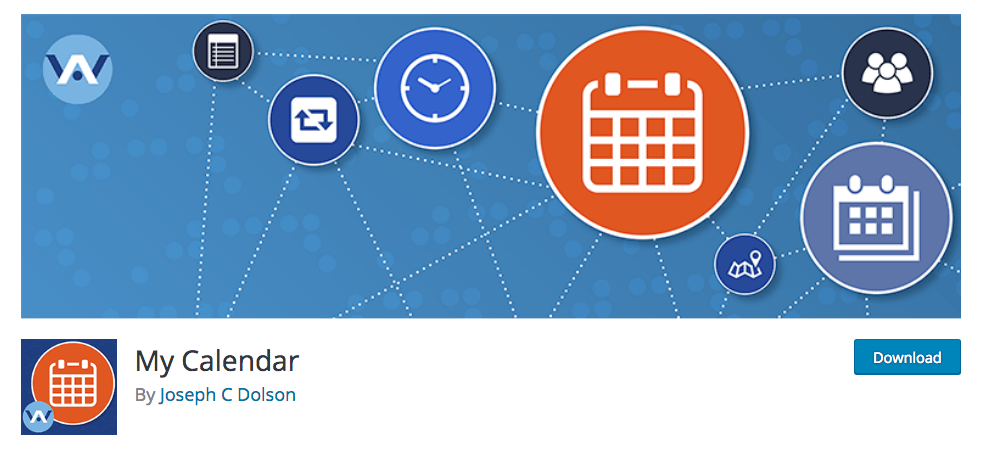
My Calendar is likely the best option for adding multiple calendars on your WordPress website, or if you have multiple sites that need to display the same calendar. My Calendar is multi-site friendly, so you can add calendars to a network of sites that you’re managing directly from a single WordPress install. So you can essentially share events within the network by fetching them from a remote database. Unlike other plugins that we’ve seen so far, My Calendar has a mini-calendar view, which is ideal for a compact display on your site or sites.
Once an event has been created, you can automatically have it posted to Twitter, set up email notifications whenever a new event is scheduled, and you can easily schedule and manage recurring events.
You’ll also have the option to create custom templates for your calendars. If you’re a designer or developer, this plugin will give you lots of flexibility to create custom calendars for your WordPress site.
Conclusion
There you have it. These are the top six WordPress calendar plugins of 2019.
Use this guide to determine which plugin is the best for your website. Not all of these plugins offer the same options and functionality. So you’ll want to make sure that you find one that covers your needs.
At the same time, you don’t want to get a WordPress calendar plugin that’s too complex. If you need something that’s simple, you can find an option that’s more on the basic side. Like I said earlier, one of my business mantras is: No unnecessary complications. Keep it simple. Whizbang features you don’t need can slow you down, instead of speeding you up.
There are tons of other WordPress calendar plugins, but in my experience, these are the best ones.
Source Quick Sprout http://bit.ly/2GJqLWk

